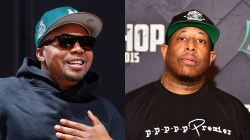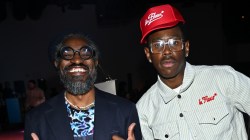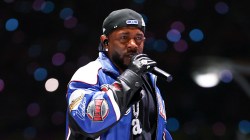Despite 3,000 miles of ocean separating the French Republic from New York, the culture of Hip Hop with all its tenets has grown rapidly since the ‘70s and ‘80s—perhaps faster in France than any other country in Europe. It is here where DJ Jean Maron, a 38-year-old producer, has been shaping his sound and watching the music of the United States—even when the US didn’t care to look back. In 2010, Maron, and Boston emcee M-Dot, released Run MPC. With a fair array of samples, scratches and running-paced drums, the album’s sonic framework was solid yet slightly predictable in its attempt to recreate and preserve “real Hip Hop.” Four years later, with names such as Kool G Rap, ONYX, KRS-One, Brand Nubian and Masta Ace to provide co-signs on his latest True School, Maron has found himself dissecting this concept of “real Hip Hop,” and in doing so has found moments of authenticity, but more moments of disillusionment.
Within the very first seconds of the album, DJ Jean Maron with the help of Kool G Rap, begins defining the idea of “true school” as an essence, mostly found within the past but not limited to it. Kool G spits a brief but successful verse that acts as a time machine.
“Flashback to the mid ‘80s,” he begins, referencing people like Salt-n-Pepa and his early coke career to provide more context. A little further into his verse, G Rap then takes a wormhole into the present, contrasting the Golden Era with the new millennium, rhyming:
“Mike Tyson, was striking with the height of a bison / Forever a legend in my book, the livest crooks / Now let’s shoot back to the present, in two flash seconds / No heavyweight division.” With a clever analogy to boxing, G Rap deviates from the normal old school versus new school argument; instead of simply dismissing newer rappers, he is specific in his critique about their level of competitiveness.
With such an argument serving as the basis for the project, Maron provides a rubric for which to judge the music—a rubric that he himself ultimately falls short of. “True School,” the first single and namesake of the album, which features KRS-One, is an example of how the album, despite its attempt to return to a “source” of this “essence,” fails. KRS utilizes his usual matter-of-fact tone and straight-forward speech that can sometimes be seen as presumptuous, in order to deliver some memorable lines such as, “You got to love the fact that I still rap / Hip Hop culture, I live that ‘cause I built that.” In general, it’s typical KRS. However, there has to be some accountability on behalf of the Bronx legend for having other lines such as, “Fuck a desk a lunch break / Coming through that red tape / Temple of Hip Hop, that’s the es-cape,” where the rhyming is lazy. With a Jimi Hendrix, “Purple Haze” sample, Maron and KRS ultimately craft a song that does have some edge and is more hit than miss.
Continuing with the rest of the album, there is a noticeable difference halfway through. “Get Up” by ONYX and “You Can’t Hide” by M.O.P. are rather strong up-tempo tracks, and Maron provides a certain consistency through instrumentals by incorporating a b-boy approach of funk and drum breaks. However, after the REKS a capella rap that shouts out those who participated in the project, Maron makes the biggest mistakes when it comes to fleshing out songs with a less aggressive focus that are more thematic.
Perhaps the most essential songs in terms of substance and having a concept, “Itinerary,” “It’s Too,” and “Forbidden Love,” continue to show Maron’s conflict of having small breakthroughs while suffering major set-backs. The breakthroughs come mostly through the insight of the OGs who insist the problems of Hip Hop attributed to the new school have actually been around since the Golden Era. On “It’s Too,” Masta Ace admits, “I’d be lying if I said we wasn’t crying or complaining about the same damn things back in our days,” and uses the success of rappers like Vanilla Ice as one example. The setbacks come from the quality of the songs; at times they’re hard to digest. Ace’s verse aside, the JTronius hook is woefully off key and distracts from the rest of the song. “Itinerary,” replaces a conventional hook and instead includes a voice from a car navigator giving directions, which is absolutely not a good idea. “Forbidden Love,” shows some potential, but after the first verse begins to drag.
It must be made clear that True School, despite its admirable investment in “real Hip Hop”—however loaded that term has become—provides nearly as many problems as answers. If there is something lacking in today’s emcee and something inherently essential about their forefathers, then it would presumably be true that Maron’s album would be a stronger body of work. This is not the case and is compounded by the lack of a standout a track—something to point to and say, “This is what’s been missing.” So Maron along with his slew of Golden Era legends, and the rest of the Hip Hop community, new and old school, are still presented with this daunting reality that Rap remains divided in terms of generations, regions, Trap and Boom Bap, and that may be as “true” as you’re going to get.



![Method Man Admits He Didn't Like Drake's "Wu-Tang Forever": "I [Wasn't] Getting On That"](https://hiphopdx.com/wp-content/uploads/2025/12/method-man-drake-wu-tang-forever-remix.jpg?w=250)






that mobb deep joint is so fuckin’ dope, i mean sooo fuuuckin dooopee !!! why they can’t alway do shit like this man
Album was also reviewed here: http://www.rapreviews.com/archive/2014_05_jeanmarontrue.html
And editor review song by song is so different. Looks like they both didn’t listenned to the same album …weird
4 or 4.5 to me
Weak.
Album is amazing! The transition from beats to full songs, to the skits, the intro and more. You must be outta your mind giving it 3.
I’m rating it a little upper than what I usually would have just to express that I don’t agree with Dean Mayorga judgment.
one of my fav picks of this year for sure!!!
Timeless
adf
Hello, Mr. Dean The Critic,
First of all, I won’t have to bash your article for long, cause you made a big mistake from the start when you wrote it. You acted like those phony judges at The Voice, and told someone…you failed.
For the real aware heads, people with no PORTFOLIO and too much BLAHBLAH are often not relevant, and these people often happen to find themselves a niche in the critic and review business.
…I think that you forgot to sleep or forgot to have sex last night, before you wrote that
Instead, magine all those satisfied ears, where True School from Dj Jean Maron has not failed. Canada France Boston, NY, god damn, everyone around me is asking; whos that guy even brought back L.O.T.U.G? I tell em Mr.Jean Maron…..in my opinion, you are just bored with music, and not listening with ears and heart that need real music, but with the need of producing a critic. Thats the difference.
And now you are probably asking yourself geez, do I really love my job!? I feel like a bastard. Well maybe not because that article seemed to be written by a robot who likes to quote lyrics, just to show-off he did some kind of documentation.
Take this hiphopDX or whatever website opinion seriously, or make your own, but one thing is true is that Jean Maron brings true quality beats, real artists from the golden era, and probably produced the best joint with Onyx I heard within all the comeback song range they did with foreign producers (not to name any cause I love them all). One thing is sure, the price is low for an album so much packed with great new-new-new-new-era classics. A classic can be born anytime even if 1997 is behind us.
Let me get back to this argument: LORDS OF THE UNDERGROUND. Do I need to say more!? No. Listen.
Another argument: DOUBLE LP including fresh instrumentals.
My final argument: GOD DAMNIS THERE ANY TRACK THATS NOT 100% FRESH AND KEEPS US GOLDEN ERA 91-96 FREAKS IN OUR FREAK MODEI SAY FUCK YESSSS! and I say thanks for another dose of PERMANENT HITS , DJ Jean Maron. The drums are rusty. The samples are dusty, production is ultra thight, this is one of the best freakin feature album produced by a DJ for years.
Anyway a critic is just a critic, and like they said on the last De La Soul albumOpen the Door, Dean.
Open your ears, Dean, Naaaah Mean!?’
PS: in my opinion, the more you feel a production in your veins, the better it is, and not try to prove the public that you dig through all the lyrics methodically to give yourself a credible critic status.
Thank you
Remi DJ REMZINATOR Jobin
Canada
OPEN THE DOOR DEAN!!
Oh yeah and here’s my vote. Peace.
?
Phaaaaat Album !
Dj Jean-Marrooooonnnnn !!!
Some really nice tracks and really fat beats!!! Big up!
where are the other comments ?
I saw my post like 2 seconds then it disepear. Already 16 comments but none are displayed ??!! weird
boring as hell
les critiques sont souvent des artistes rats ( in my own opinion ) You think that KRS1 used easy rimes but it’s one of the untouchable Mc’s because of his way of thinking, he analyses the american society with a gun eye !!! About the using of GPS voices by Dj Jean Maron, he’s just followed our times and creates a new fresh style for which is turning around and that i feel poorer between the old school ” qu-blo ” and the Trap or things sounding like Techno what ??? I love HH and DJ Jean Maron too !!!!
I still can’t read my comment ?? technical support ??? whre are you ??
“Itinerary, replaces a conventional hook and instead includes a voice from a car navigator giving directions, which is absolutely not a good idea”, are you serious ?
Great album, nothing to complain about. Jean Maron brought back the sound of yesterday
The comment section bug stills not fixed. I can’t read no comments ??
Not feelin it
solid compilation right here boiiiiii. A few more tracks could have been an asset. 4.5/5